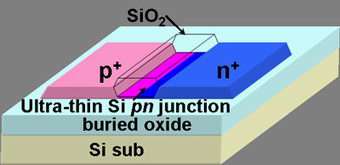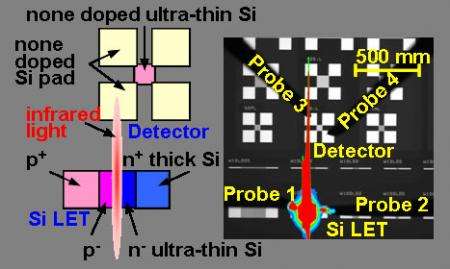November 1, 2006 feature
Light-emitting transistor uses light to transfer an electrical signal

In one of the early discoveries of the current "silicon electrophotonics era," scientists from Hitachi, Ltd. in Tokyo have built a light-emitting transistor (LET) that transfers, detects and controls an electrical signal all on a single nanometer-sized chip. Using a silicon-on-insulator (SOI) substrate, the group could optically connect the LET to a detector, resulting in a tiny chip that may integrate a wide range of microelectronics and photonics nano devices.
“With LETs, we could develop an optical interconnection beyond the present copper interconnection,” Shin-Ichi Saito, co-author of the study in Applied Physics Letters, told PhysOrg.com. “If LETs are really integrated on silicon chips, we might reduce power dissipation (since light does not have electrical resistance), as well as RC [Resistive Capacitive] delay: in electrical circuits, the interlayer coupling capacitance reduces the speed of electrical signals, while such a delay might be reduced in optical interconnections.”
Similar to a standard field-effect transistor, Saito et al.'s LET takes advantage of some interesting properties of 2D electron and electron hole systems, called “quantum confinement effects.” By reducing the thickness of the crystal silicon down to the nanometer scale, the scientists fabricated an ultra-thin single crystal silicon film, directly connected to the thick silicon electrodes. In such a design, n-type (electrons) and p-type (holes) semiconductors lie next to each other separated by a narrow junction. As the electrons and holes efficiently eliminate each other in a process called "recombination," photons are emitted; thus electrical signals can be converted to optical signals.

“With the lateral carrier injections that we used, we can efficiently inject both electrons and holes directly in the quantum confined silicon,” said Saito. “Usually, nano-scale silicon structures are passivated by SiO2, which has huge potential barriers for carriers. Such a limitation does not exist in our device.”
In this set-up, the p-n junction consists of a light-emitting diode (LED) made of ultrathin silicon. At a 9nm thickness, the silicon acts as a quantum well, confining the electric carriers to two dimensions, which forms a standing wave consisting of an electron. This confinement serves an especially useful purpose for integrating optical components into silicon circuits, as it enhances the electroluminescence efficiency of the junction. While other LETs--from carbon nanotubes and organic models to semiconductor and nanocrystal devices--have been demonstrated, Saito et al.'s is the first in which recombination occurs along the silicon junction and takes advantage of quantum confinement's electroluminescence.
“The key idea is that the 2D conduction band electrons behave just like electrons in direct band-gap semiconductors,” said Saito. “In bulk Si, the conduction band electrons move very fast with a large momentum. However, in the ultra-thin Si, the electrons cannot move perpendicular to the substrate with such a large momentum, simply because that direction is restricted. Many people also consider that this quantum mechanical confinement plays some role for the enhanced luminescence in nano-scale silicon.”
To optically interconnect this electrical signal from the LET to a detector--which were electrically isolated but on the same silicon chip--the group applied a forward voltage bias to the LET. The scientists observed the light from the LET to reach the photodetector, and measured the "photocurrent" in the detector to increase with a voltage increase, and decrease when the voltage was turned off (detector limitations caused some current to continue flowing).
Although the Hitachi group points out limitations to the present experimental set-up that need to be fixed before applying the principle to marketable technology, they suggest solutions for these problems: for example, reducing the response time of the detector and using waveguides to contain the light on the chip. However, the achievement shows how, using curious phenomena of quantum mechanics, photons, just like electrons, can be manipulated on a silicon chip. Quite possibly, future integrated circuits may use lights instead of currents to enhance performance while reducing power dissipation.
“We have just confirmed the basic operation principle for this LET,” said Saito. “The hope is that this is just the beginning of more research; we have lots to do.”
Citation: Saito, Shin-ichi, Hisamoto, Digh, Shimizu, Haruka, Hamamura, Hirotaka, Tsuchiya, Ryuta, Matsui, Yuichi, Mine, Toshiyuki, Arai, Tadashi, Sugii, Nobuyuki, Torii, Kazuyoshi, Kimura, Shin'ichiro, and Onai, Takahiro. "Silicon light-emitting transistor for on-chip optical interconnection." Applied Physics Letters 89, 163504 (2006).
By Lisa Zyga, Copyright 2006 PhysOrg.com




















